Electric vehicle fleet management
Where are you in the electrification journey? Webfleet helps every step of the way to realise an electric vehicle fleet.








The electrification of even a small fleet can be quite a journey. Where are you in the process of realising an electric vehicle fleet? We help you plan the transition, add EVs to your fleet and then make the right choices to maximise ROI.
Webfleet helps you
Spot the best vehicles
to switch over to electric, based on milage, efficiency and TCO
Monitor and manage
your ICE and EV fleets on one convenient dashboard
Track data
like range, energy consumption, mechanical status and more with just a click
Measure data
like how exactly driver behaviour and other factors influence your fleet's economy and expenses
Optimising charging choices
by lowering costs, increasing productivity and making a better ROI
Implement the best solutions
for your own electric fleet with the help of our EV experts
Key features for adding electric vehicles to your fleet
Monitor fuel usage and carbon emission dashboard Webfleet
Monitor real-time fuel consumption and emissions responsibility with our fuel efficiency dashboard and use those insights to spot the best places to begin decarbonising your fleet. Whether your fleet consists of passenger cars, LCVs or anything else, our LINK on-board devices can connect everything to Webfleet and make all your data easily available. Find out which parts of the fleet have the highest emissions and are the best to begin changing into electric vehicles.
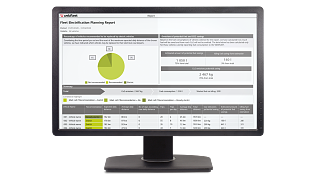
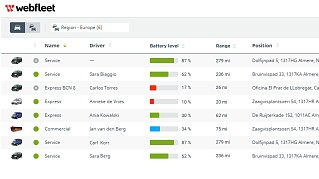
Get your fleet electrification report now
Not sure where to start replacing your ICE fleet with clean, efficient EVs? We can create a fleet electrification planning report which evaluates your current fleet and make recommendations on which vehicles could be replaced most profitably.
Talk to our EV experts
Whether you would like to know more about calculating your current fleet's TCO, comparing that to the advantages and disadvantages of an EV or hybrid fleet, or want to know exactly where to start the transition, our electrification experts are keen to help.

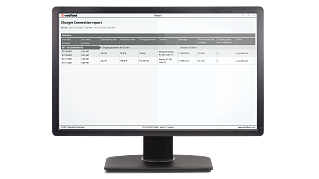
EV charging report
This historical report helps you track when, where, and for how long your electric vehicles were plugged in for charging. This allows you to gain insight into why your EVs are at their current level of charge.
Optimize your workforce planning
Charging the vehicle doesn’t have to be an issue, with the dashboard of Webfleet you will have an overview of charging stations. Plan your jobs with charging stations displayed directly on the Webfleet map, while ensuring that dispatched vehicles have enough battery charge to complete the job.
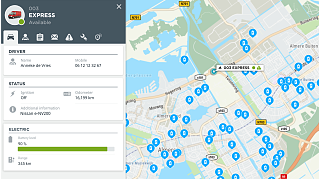
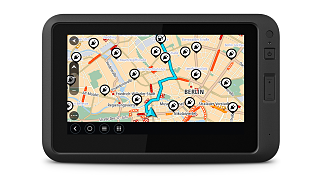
Find the closest EV charging locations on the road
Your drivers can rely on TomTom’s EV map coverage on their Pro Driver Terminal with charging points in over 50 countries throughout Australia, Europe, the Americas, the Middle East and Asia.
Notifications keep you on top of your operation
Get notified in real-time when the battery of a vehicle on the road reaches a critical level and needs to be charged.
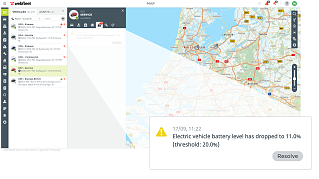
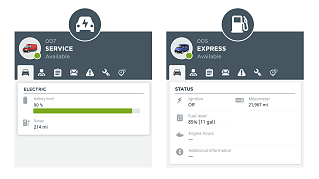
Fleet management made easy
Our Webfleet solution allows you to view, monitor, and manage your ICE, hybrid, and electric fleet all on the same platform, while offering support to drivers when necessary. Webfleet can also be integrated with a wide range of 3rd party applications, so you can build the ideal solution for your fleet.
Monitor your electric vehicles from anywhere
Right there in the palm of your hand, you can manage your whole fleet from anywhere using our Webfleet Mobile app. Most of the information is available in one touch and commands are carried out using the same intuitive tap or swipe action you use for other mobile apps.
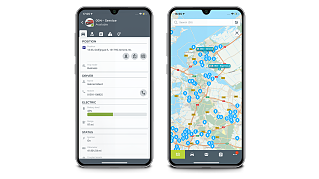
EV awards
All you need to know about EV fleet management
What is EV fleet management?
0
What is EV fleet management?
0EV fleet management is the process of running an EV fleet efficiently, safely and productively. Smart planning is crucial for effective EV fleet management—jobs should be planned according to vehicle charge.
How is EV fleet management different from the fleet management for petrol-powered vehicles?
0
How is EV fleet management different from the fleet management for petrol-powered vehicles?
0The main difference between managing an EV fleet and one that uses petrol is how you power your vehicles. With internal combustion engines, it's a matter of filling up at a petrol station. Managing an EV fleet requires planning jobs based on range capacity and recharges.
How does EV fleet management work?
0
How does EV fleet management work?
0Fleet management technology plays a significant role. You need the ability to monitor your EV locations and charge status, data that's vital to route planning and job completion. Electric vehicle fleet management software gives you greater control with notifications on battery levels. Thinking of switching to EVs? Use our free Fleet Electrification Report to analyse how much you could save on fuel and CO2 emissions by going electric. Request a free consultation
How can EV fleet management help reduce costs?
0
How can EV fleet management help reduce costs?
0EV fleet management helps reduce costs by optimising energy consumption, improving vehicle maintenance schedules and taking advantage of government incentives. Through tools like route optimisation and real-time monitoring of battery performance, fleet managers can minimise charging times and reduce energy waste.
What is the difference between ICE and EV cars?
0
What is the difference between ICE and EV cars?
0Internal combustion engine (ICE) vehicles are powered entirely by petrol, whereas a lithium-ion battery is used to power EV engines. Therefore, EVs do not generate tailpipe emissions as ICE vehicles do.
What types of EVs are available for fleet management?
0
What types of EVs are available for fleet management?
0If you are looking to electrify your fleet, there are three categories of electric vehicles you could consider.
- Battery electric vehicles (BEVs): These vehicles are powered by rechargeable batteries, making them 100% electric
- Plug-in hybrid electric vehicles (PHEVs): The batteries for these vehicles are charged either through regenerative braking or by plugging into an external power source
- Hybrid electric vehicles (HEVs): Hybrids can run on gasoline as well as electricity, which is produced with regenerative braking
What factors should be considered for EV fleet management?
0
What factors should be considered for EV fleet management?
0When managing an EV fleet, consider the following factors to ensure cost efficiency and operational success.
- Total cost of ownership (TCO): Evaluate the long-term costs of owning and operating EVs, including purchase price, maintenance and fuel savings. compared to traditional vehicles.
- Charging infrastructure and availability: Assess the availability and suitability of charging stations for your fleet's routes and operations. This includes planning for on-site charging stations and understanding public charging network coverage.
- Battery life and replacement costs: Monitor battery health to determine the lifespan and potential replacement expenses, ensuring it aligns with your fleet's financial goals.
- Driving range and operational needs: Match vehicle range with the daily travel requirements of your fleet. Consider factors like weather and payload, which can impact range.
What are the key benefits of an electric vehicles fleet?
0
What are the key benefits of an electric vehicles fleet?
0- Lower running costs than ICE vehicles: Eliminating your fleet's need for fossil fuels means there’s no need to budget in gasoline expenses. On average, an electric vehicle will accrue less than half of the travel costs of an ICE vehicle across the same distance.
- Simpler and cheaper maintenance: EVs have fewer moving parts, which means fleet managers can save thousands a year on maintenance costs, approximately one third of the cost of maintaining ICE vehicles.
- More vehicle data to improve performance: Combined with an EV fleet management system, additional vehicle data will help fleet managers monitor and calculate how cost effective it has been to add EVs to their fleet.
- Massively reduced carbon footprint: Contribute to better air quality by lowering your fleet emissions.
- Leading the way: EVs offer the chance to be a market leader by adapting quickly to the technological shift.
What are the environmental benefits of switching to EV fleets?
0
What are the environmental benefits of switching to EV fleets?
0Since EVs don’t generate any tailpipe emissions, they’re essential to improving air quality. Electric vehicles help fleets comply with increasingly strict environmental regulations, including zero-emission zones.
Are EVs cost effective for long-term fleet use?
0
Are EVs cost effective for long-term fleet use?
0Yes, EVs are cost effective in the long run thanks to lower fuel and maintenance costs, government incentives and lowered environmental penalties.
What challenges are associated with managing an EV fleet?
0
What challenges are associated with managing an EV fleet?
0Challenges can include:
- Initial investment in vehicles and charging infrastructure
- Limited charging stations in some regions
- Adapting operational schedules to account for charging times
However, these challenges can be mitigated with careful planning and by leveraging fleet management solutions that help optimise routes and charging schedules.
What is the role of technology in optimising EV fleet management?
0
What is the role of technology in optimising EV fleet management?
0With an EV fleet management system, it’s easy to monitor and calculate how cost effective the addition of EVs to their fleet has been. By analysing key metrics like battery levels, charging status, energy consumption and maintenance needs, fleet managers can make informed decisions.
How can EV fleets help businesses comply with regulations?
0
How can EV fleets help businesses comply with regulations?
0By adopting EVs, your fleet can comply with stricter regulations and benefit from government incentives to foster sustainable transportation. Additionally, the Corporate Sustainability Reporting Directive emphasises the need for businesses to demonstrate their environmental performance, including reductions in carbon emissions. EV fleet management supports compliance with reliable emissions data and simplified reporting.






Your consent is required
In this section, external content is being embedded from .
To display the content, your consent is required for the following cookie categories:
- Targeted Advertising
- Analytics & Personalization
- Essential
For further details, please refer to our privacy policy. If you are interested in how ###vendor_name### processes your data, please visit their privacy policy.








